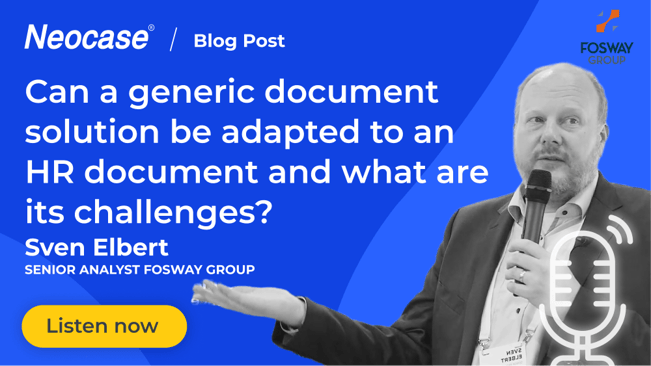This article is based on our latest podcast 👇
In this Fosway Analysis Podcast Series, we had the pleasure of interviewing Sven Elbert, Senior Analyst at Fosway, on several current HR topics such as Employee Journey, HR documents, Employee Requests and Employee Relations.
Discover in this episode why Employee Document Management is such an important topic and how to overpass its complexity and challenges.
.png?width=147&height=147&name=vignette-podcast-Fosway-XX-Neocase%20(1).png)
👉 The Fosway Podcast - Episode 2: Can a generic document solution be adapted to an HR document and what are its challenges? 👈
Can a generic document solution be adapted to an HR document?
Not every HR agent can see all the HR documents
"We see so many different types of documents and there are so many sensitivities around who can see what (salary data, compensation, benefits data,...) not every HR person can see salary data, right? They might only see performances or some specific things for their area of responsibility, but not necessarily payroll or combined data.
And the same is true for different employee target groups: for executives, and higher-level managers, there is more sensitivity around who can see their data, so this is difficult in itself to manage these two things but if you combine who can see compensation benefits data for executives, it becomes another level of complexity.
➡️This is something that HR solutions manage on a day-to-day basis.
Everyone in the product design teams of those organizations is definitely very familiar with those kinds of problems. So it's very natural for those kinds of solutions.
If you multiply this with regional or business unit-specific views, you get the problem gets increasingly worse... There is a whole access to information problem.
I think that is one where HR vendors usually have better insight into all these kinds of complexities that need to be managed by HR teams."
Complexity to adapt to GDPR
We maybe don't want and don't like to hear it, but there are certain rights that employees and workers have with employers.
💭 the right to be forgotten
💽 the right of data transferability
⛔ the right to object
❌ the right to restrict data processing.
You need to lock things. If an employee says "no, I object", you really have to stop processing things and how do you do this?
➡️ These are some of the requirements that also these HR vendors are very much used to because of every implementation they are getting us these kinds of questions by HR teams, by the data protection officers, and by IT security officers."
What are the challenges HR teams are facing regarding managing people's documents?
"There are so many and it's quite basic.
If you're in a Shared Service Center and you are covering a wider region. For example, you're responsible for Germany, France and the UK, and you already have three languages. But think of the Nordics and Spain, all these others, It's difficult to understand what is written on these kinds of documents.
If you must file them to a certain location, you must think about the access rights! Being driven off of that is really dangerous because you might file it into a different location.
💭😱 Imagine, all of a sudden, the salary data is visible for someone that actually shouldn't see them.
It's maybe just an operational detail, but another big challenge is around document retention periods and managing that complexity on an international basis.
There are different rules. You want to make sure that documents get deleted when an employee asks for them to be deleted. You also, at the same time, want to stop documents from being deleted if an employee asked it, or if you have other reasons that by law require you to store them.
This matrix is really difficult for people to keep in their heads and I think technology can help to ease the process a lot and free some time and some worry for HR people as well.
➡️So automation definitely is one of the things.
What are the key figures to manage HR challenges?
As I said, it's probably around the flexibility to be able to set this up so the retention policies can be different by country, and can be different by organization. So if you have multiple operating countries and companies in a country, you might have to have different settings for those entities.
It becomes really quite complex and solutions can struggle with that.
➡️ If you're looking for a tool, make sure that you understand for one, the complexity that you have and that you need and then make sure that the solution that you are looking into supports those requirements and can handle that complexity.
👉Learn more about the Neocase Document Management solution👈
As analysts, we also are looking at the hot kind of stuff.
Artificial intelligence is the hype topic. There is some opportunity to use some of that. Ideally, you don't notice it when it's done very well. You can just get the right recommendations and that's fine maybe how to classify documents or how to send them on who maybe gets some permissions on them.
➡️So I think there are definitely those kinds of things I would look for in a solution."
Podcast led by Raphaële Coutant-Roch, Product Marketing Manager at Neocase.
Guest speaker : Sven Elbert, Senior Analyst at Fosway Group.

 Microsoft Teams
Microsoft Teams
 Workday
Workday

